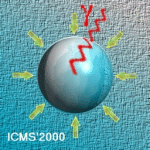
ICMS'2000
The International Conference on Multiphase Systems, ICMS'2000
Ufa, RUSSIA, June 15-17, 2000
Nigmatulin R. I.
Tyumen Institute of Mechanics of Multiphase Systems
of R. A. S., RUSSIA;
Ufa-Bashkortostan Branch of R. A. S., RUSSIA;
Center for Multiphase Research, Rensselaer Polytechnic Institute, USA
Non-reversible multiphase flows are considered when it is necessary to take into account different average fields of velocities, temperatures and pressures of the phases.
1. The relation between various popular forms of the two-fluid model is shown. The current state-of-the art in the modelling of interfacial and intraphase closure laws is summarized. New closure laws are proposed which attempt to account for the effect of dispersed phase interactions and achieve closure and well-posed models.
2. Quasi-static approximation (drift model) is considered. Non-trivial theoretical equations for slip velocity for dispersed and slug gas-liquid flows are derived. Juxtaposition of the derived equations with the Zuber-Findlay correlation is used as an experimental information to get the information on the interphase forces.
3. Some popular theoretical delusions and myths (Einstein viscosity of suspensions, Zuber & Findlay correlation interpretation, Landau sound speed in the liquids with vapor bubbles) are presented.
4. Some unusual effects in two-phase flows and in the theory are discussed. Some of them are:
- identity of different forms of momentum equations;
- reason and non-dramatical sense of non-hyperbolicity of classical two-velocity equations;
- evolution of pressure distribution for wave propagation in bubbly liquid is described not by hyperbolic, but elliptic Poisson equation;
- gas-particle suspension flow over a blunt body with the particles reflected from the body;
- convective propagation of the combustion zone in gas-powder mixture with hot and cold "wind", when the minimum concentration of combustible powder for transition to explosive detonation may decrease with decreasing the dimension of the particles;
- the nature of the slow evaporation after rarefaction and then explosive evaporation in the outflow of the flashing liquid with rarefaction waves;
- principal features of wave propagation in gas-drop or liquid-bubble mixtures are presented;
- a new system of ordinary differential equations for evolution of the radius of small gas bubble in the center of a spherical flask filled with a compressible liquid, that is excited by small radial displacement of the flask's wall, is presented.
5. A few non-traditional applications of multiphase systems in power, nuclear and thermonuclear, chemical, petroleum and safety engineering are discussed.